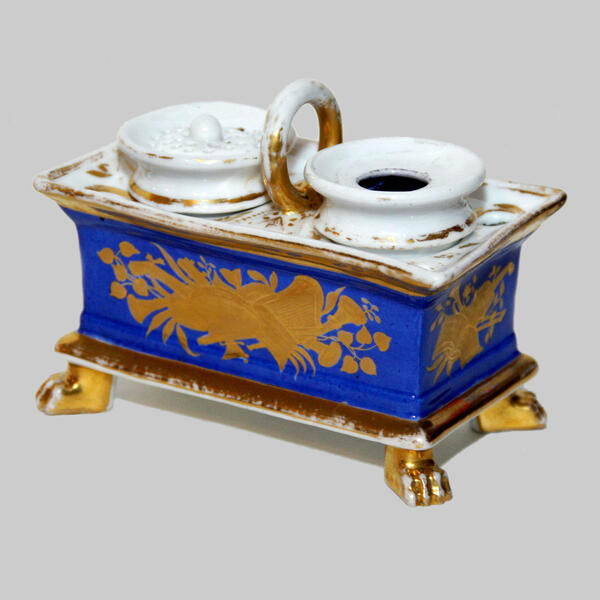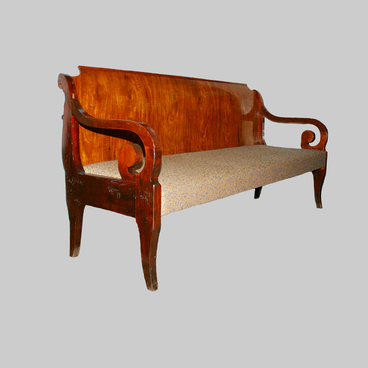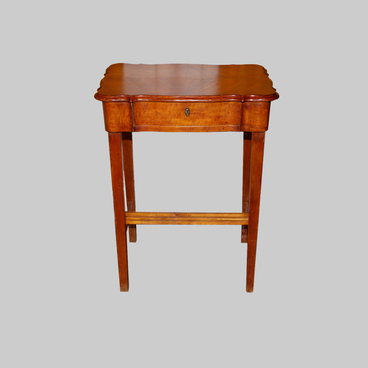In 1995, the Yalutorovsk Museum of Local History in Memory of the Decembrists, which was renamed a year later and is still called the Yalutorovsk Museum Complex, received an old ink set. It was made in the Russian Empire in the first half of the 19th century. The story of the porcelain ink set was lost. We do know that the last owner of the item was Alexander Sidorov, employee of the A.S. Pushkin State Museum. Sidorov bought it in a Moscow antique shop. The ink set is included in the Decembrists in Yalutorovsk display, opened in the memorial house of Matvey Muravyov-Apostol. Retired Lieutenant Colonel Matvey Muravyov-Apostol, who was a nobleman, a Decembrist, and a hero of the Patriotic War of 1812 and foreign campaigns in 1813-1814, lived in this house from 1836 till 1856.
The porcelain ink set consists of three parts: a stand, an inkwell and a sandbox. As of the mid-18th century, ink sets were sold with a sandbox included. It was filled with dry river sand. They would sprinkle it on a sheet of paper with fresh writing on it to dry the ink. With the invention of blotting paper, sand application was abandoned, but ink sets with sandboxes were produced until the middle of the 19th century.
The stand is made in a rectangular shape on four legs-paws with a handle-ring. Inside, it is hollow with two large round holes for an inkwell and a sandbox and four small ones for pens. The side walls are covered with blue glaze, on each side there are different compositions made up of musical instruments and fruits painted gold. The inkwell itself is conical in shape, with two annular projections on top, and a round hole and gold-colored border around the edges of the projections. The sandbox is shaped like a cone with two annular protrusions. At the top of the lid, small round holes are made in the form of a salt shaker.
Ink sets held a special place on writing desks in the 19th century. They were used in conducting business correspondence, keeping household books, completing documents, and writing letters. Matvey Muravyov-Apostol remade one of the rooms in his house in Yalutorovsk into a study. Here he wrote letters to his sister Ekaterina, filled out a meteorological journal.
The porcelain ink set consists of three parts: a stand, an inkwell and a sandbox. As of the mid-18th century, ink sets were sold with a sandbox included. It was filled with dry river sand. They would sprinkle it on a sheet of paper with fresh writing on it to dry the ink. With the invention of blotting paper, sand application was abandoned, but ink sets with sandboxes were produced until the middle of the 19th century.
The stand is made in a rectangular shape on four legs-paws with a handle-ring. Inside, it is hollow with two large round holes for an inkwell and a sandbox and four small ones for pens. The side walls are covered with blue glaze, on each side there are different compositions made up of musical instruments and fruits painted gold. The inkwell itself is conical in shape, with two annular projections on top, and a round hole and gold-colored border around the edges of the projections. The sandbox is shaped like a cone with two annular protrusions. At the top of the lid, small round holes are made in the form of a salt shaker.
Ink sets held a special place on writing desks in the 19th century. They were used in conducting business correspondence, keeping household books, completing documents, and writing letters. Matvey Muravyov-Apostol remade one of the rooms in his house in Yalutorovsk into a study. Here he wrote letters to his sister Ekaterina, filled out a meteorological journal.



